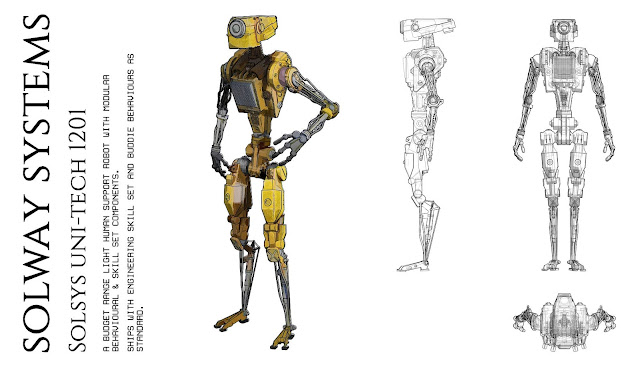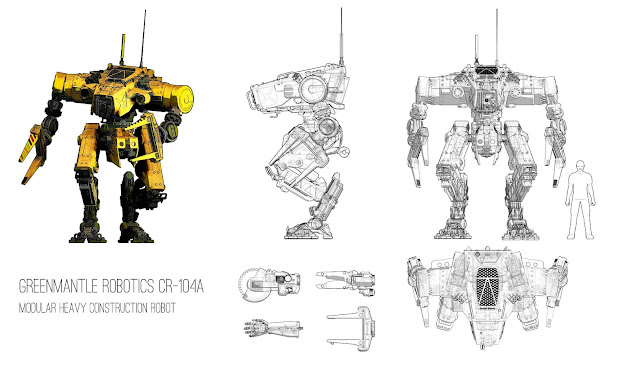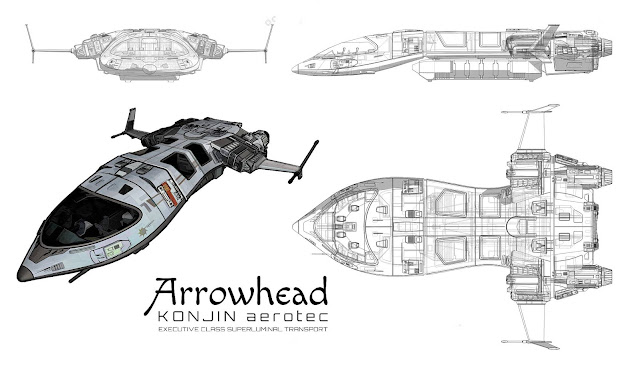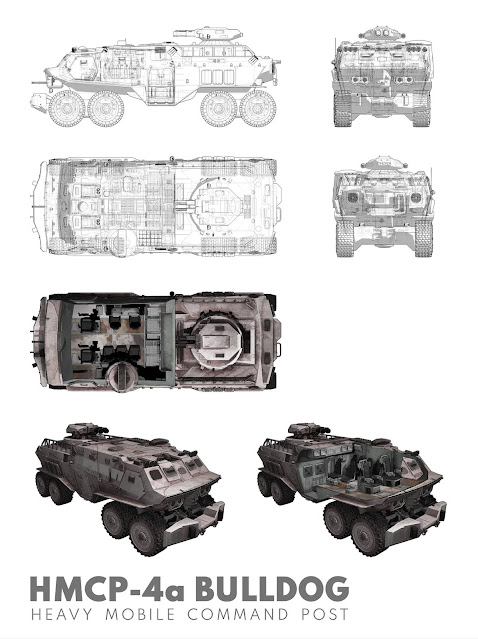As I
look to construct a campaign for the Alien RPG, I want to lay out a
few thoughts about robots and the artificial people of the Alien
Universe. I’ve also included some ideas for robots that will
feature in the campaign. This is all material that will form part of a player's handbook to the Three World Empire.
Artificial Intelligence comes in different flavours.
Soft AI deals with intelligence but not personhood, though it can
include imitating it through algorithmic behaviours that amount to a
sophisticated version of if a, then do b. These employ
conventional computers with software.
Strong AI deals with recreating human-like intelligence or
personhood. As our conventional computing doesn’t really model our
brains, it would make most sense to me to create an artificial brain
that is functionally the same as a human brain.
Being engineered, there is scope to design differences but the
greater the differences, the greater the risk to empathy—of humans
being unable to relate to an android, or of an android being unable
to relate to a human.
Reasoning and information processing are likely to be faster in an
android, though there will also likely be some limit due to the
physical limitations of duplicating a human brain.
They will have two types of memory available. The primary type
will be their personal memory, formed in the manner of human
memories, which, while better than human, will also be subject to
human limitations. This may be augmented by recorded sensory data and
digital storage—it will not be their memory as such but information
readable via a direct ‘neural’ link.
An artificial brain will no more be programmable than a human one
but, at manufacture, it may be possible to hardwire limitations on
certain emotions (though some measure of emotion will be necessary
for them to be persons), and creative capacity (again, you would need
to retain some creativity as this would limit their capacity for
problem solving), while also instilling loyalties, predilections, and
behavioural inhibitions. It may even be possible to employ a measure
of conditioning for codes of behaviour, though conditioning would
certainly be breakable under the right circumstances, as it is in
humans.
An upshot of this is that languages, understanding, knowledge, and
skills will have to be learned. Androids cannot simply come off an
assembly line, be packaged with software, and sent out to a customer.
They will need to be schooled, trained, and conditioned for their
roles, both professional and social.
Reproducing human brain function involves some risk, introducing
the possibility of the same psychological problems as suffered by
humans. Further, tampering with those functions can introduce new
problems.
By contrast, androids driven by programmed imitations of humanity,
will be a little different. Subject to their programming, they will
be more compliant and controllable but also be burdened with the
limitations of computer processes and with not quite passing for
human—the uncanny valley of personality. To some extent, the
limitations of working with the computer processing that can fit into
the machine’s body/head, can be overcome by their behaviour being
governed by a connected mainframe computer, though at the cost of
being truly independent.
Some androids are manufactured with little or no effort to pass
for human, using the human form only because they will be operating
in a world designed by and for human beings. The only example of
these that we have seen in the franchise so far is the Worker Joe, a
mechanical frame beneath a flesh tone rubber insulation layer, with a
simple AI that is usually overseen by a central mainframe computer.
I’ll be calling these Human Support Robots, or HSRs.
Synthetics are exceptionally costly and cannot be commonly
afforded. Robots however, can be manufactured at much lower costs and
we should expect to see them a lot.
In the 3WE, there are two major robotics manufacturers,
Greenmantle Robotics and Solway Systems. I’ve found some 3D models
that I feel lend themselves to this setting and have used them to
illustrate some examples of common robots.
The single most common HSR on the market is Solway Systems’
budget line, the Solsys Uni-Tech 1201. With models ranging between 4
and 5 feet in height, they are at the short end for HSRs but despite
their stature and light frame, they are strong, hard wearing, and
reliable.
Their fairly basic OS can only support simple behavioural sets but
they can run very sophisticated skill sets. As standard, they ship
with a ‘Buddie’ behaviour set and the highly regarded Solsys
Engineering Skill Set. As a common engineering tool, they have become
known as Spanners.
The Greenmantle 50 series HSRs feature a light frame between 6 and
6 ½ feet in height. There isn’t a great deal of plating on the
body but they are very agile. A highly adaptable assistant, they can
fill many roles but have found a lot of use within the Colonial
Constabulary. They come with a human moulded face-plate that has led
to them being derisively called Creeps.
The Greenmantle 70 series HSRs feature a very strong frame with
lots of heavy body plates. While they see service with both the
Military and the Colonial Constabulary, they are most commonly found
on construction sights. They are sometimes called Blockheads.
The recent Alien novel, Into Charybdis features robots called The
Good Boys. Built like dogs, they are used to flush out the xenomorphs
as well as to attack them.
The Greenmantle QSR-30 series is a quadruped robot that takes its
form from a dog. Strong, fast, and agile, they have found favour with
the Military and Colonial Constabulary as guards, recon robots, and
attack dogs.
Greenmantle’s CR-104 is a heavy construction robot with a range
of exchangeable parts for its arms, including hands, saws, loader
forks, and cutters. A military model was produced with weapon parts
for the arms but it hasn’t found favour with the 3YE
military—though there were some limited sales to corporate
customers. This is very commonly found in off world construction
projects but also with some heavy transport ships dealing with large
cargoes.




















